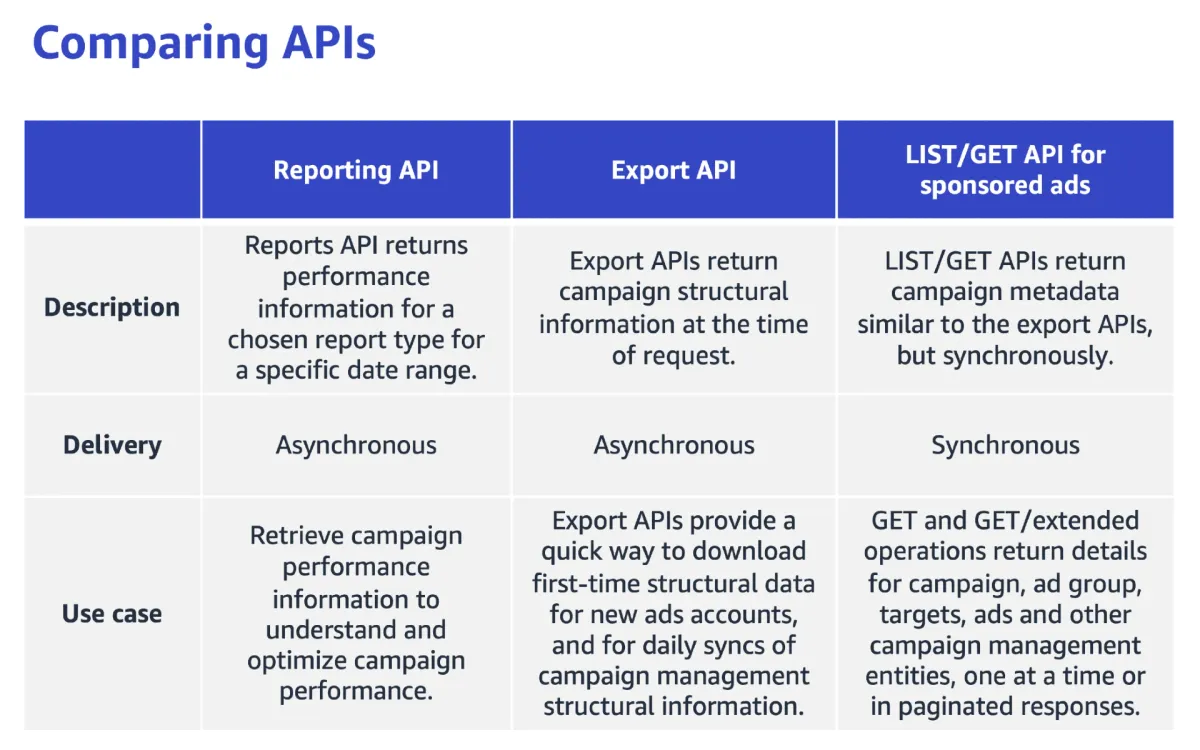
Amazon Ads this week announced the introduction of new export APIs, designed to enhance the way advertisers access and manage campaign data across various ad products. This development, set to replace the existing snapshots API functionality, promises to streamline the process of downloading campaign management data for Sponsored Products, Sponsored Brands, and Sponsored Display campaigns.
According to the official guide released by Amazon Ads, the new export APIs offer a common model and format across ad products, providing a consistent interface that simplifies the developer experience. This move comes as part of Amazon's ongoing efforts to improve its advertising platform and offer more efficient tools for marketers and agencies.
The export APIs bring several key improvements over the previous snapshots functionality:
- Unified Access: A single endpoint now serves all sponsored ads products, significantly simplifying the developer experience. This consolidation allows advertisers to retrieve data for multiple ad formats through a single interface, reducing complexity and potential points of failure.
- Comprehensive Data Retrieval: Advertisers can now download entity details for all supported sponsored ads products in a single call. This capability greatly reduces the number of API requests needed to gather comprehensive campaign information, potentially improving system performance and reducing latency.
- Standardization: The new APIs introduce a standardized structure and field naming convention across sponsored ads products. This consistency makes it easier for developers to work with data from different ad formats, potentially reducing errors and simplifying code maintenance.
- Extended Information: The export APIs achieve parity with the existing LIST endpoints, including extended fields. This means advertisers have access to a more comprehensive set of data points for each campaign, ad group, target, and ad.
- Broader Support: Unlike the previous snapshots API, the new export APIs support all versions of Sponsored Brands campaigns, including Sponsored Brands video, version 3, and version 4 campaigns. This expanded support ensures that advertisers can access data for all their Sponsored Brands initiatives through a single, unified interface.
The introduction of these new APIs addresses several pain points that advertisers and developers have faced when working with Amazon Ads data. By providing a more unified and comprehensive data access method, Amazon aims to empower advertisers to make more informed decisions and optimize their campaigns more effectively.
One of the most significant changes is the asynchronous nature of the export APIs. While this might require some adjustments in how developers interact with the system, it allows for more efficient handling of large data requests. The asynchronous model can potentially reduce server load and improve overall system responsiveness, especially during peak usage periods.
The export APIs cover four main entity types: campaigns, ad groups, targets, and ads dimensional data. Each of these entities provides specific information that advertisers can use to analyze and optimize their advertising efforts:
- Campaigns: Includes data on optimization bid strategies, budget caps, and tags.
- Ad Groups: Provides information such as ad group ID, delivery status, and default bid.
- Targets: Covers various targeting options including auto, keyword, and product category targeting.
- Ads Dimensional: Offers details on product ads, images, and video content.
It's important to note that the new export APIs will completely replace the functionality previously provided by snapshots. Amazon has set a firm deadline of October 15, 2024, for the deprecation of snapshot APIs. After this date, all advertisers and developers will need to have migrated to the new export APIs to maintain access to campaign data.
To assist with this transition, Amazon has provided a migration guide that outlines the key differences between snapshots and exports, as well as the steps needed to update existing integrations. The guide includes detailed information on endpoint equivalencies, changes in data structure, and new features available through the export APIs.
For developers and advertisers accustomed to working with the LIST/GET APIs for sponsored ads, it's worth noting the differences between these synchronous operations and the new asynchronous export APIs:
- The LIST/GET APIs provide immediate, synchronous responses, making them suitable for retrieving details about individual campaigns or small sets of data.
- Export APIs, while asynchronous, are designed for bulk data retrieval, making them ideal for initial data population or daily synchronization of campaign management information across large accounts.
The introduction of these new APIs aligns with broader trends in the digital advertising industry, where access to comprehensive, real-time data is becoming increasingly crucial for campaign success. By providing more robust and flexible data access tools, Amazon is positioning itself to better compete with other major digital advertising platforms.
As the digital advertising landscape continues to evolve, tools like the new export APIs play a crucial role in helping advertisers navigate the complexities of multi-channel campaigns. The ability to quickly and efficiently access comprehensive campaign data can lead to more agile decision-making and potentially improved return on advertising spend (ROAS).
Key facts about Amazon's new export APIs for advertisers
- Announced on September 8, 2024
- Replaces existing snapshots API functionality
- Provides a unified endpoint for Sponsored Products, Sponsored Brands, and Sponsored Display campaigns
- Offers asynchronous data retrieval for improved efficiency
- Supports all versions of Sponsored Brands campaigns, including video
- Introduces a standardized data structure across ad products
- Includes extended fields for more comprehensive data access
- Will be mandatory after October 15, 2024, when snapshot APIs are deprecated
- Designed to simplify data retrieval and improve developer experience

